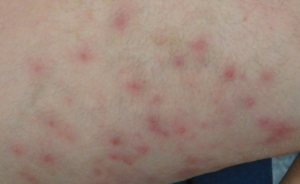Chapter 5: Acneiform Disorders
Folliculitis
What is it?
Folliculitis refers to inflammation of the hair follicle. This can be caused by both infectious and non-infectious causes. Bacterial folliculitis from S. Aureus is the most common cause. Dermatophytes and Malassezia yeast can also cause folliculitis. Other infectious causes are rare. Non-infectious etiologies include irritant folliculitis, related usually to occlusive products or friction, culture-negative folliculitis, and more rarely can be drug-induced or eosinophilic folliculitis.

What does it look like?
There are follicular-based pustules with an erythematous rim. It is most common on the head and neck, especially the scalp and beard, as well as the upper trunk, buttocks, thighs, axillae and groin. Hot tub folliculitis refers to infection with Pseudomonas aeruginosa and occurs from using a hot tub that has not been properly maintained. It occurs primarily on the back and legs that have been exposed to the water. It is often pruritic. Fungal folliculitis is often called Majocchi granuloma. This presents as follicular pustules, papules and nodules. It is commonly seen following improper treatment of tinea corporis or cruris with a topical corticosteroid.
How is it treated?
Folliculitis can be treated by cleansing of the area with an antibacterial soap several times per day and the use of a benzoyl peroxide wash. Topical antibiotics can be added if deeper lesions or more wide-spread area of involvement is noted. If severe, or systemic symptoms are present oral antibiotics may be necessary. A swab should be taken prior to initiating oral treatment. Topical antifungals are helpful in folliculitis caused by yeast, but fungal folliculitis requires oral therapy.

